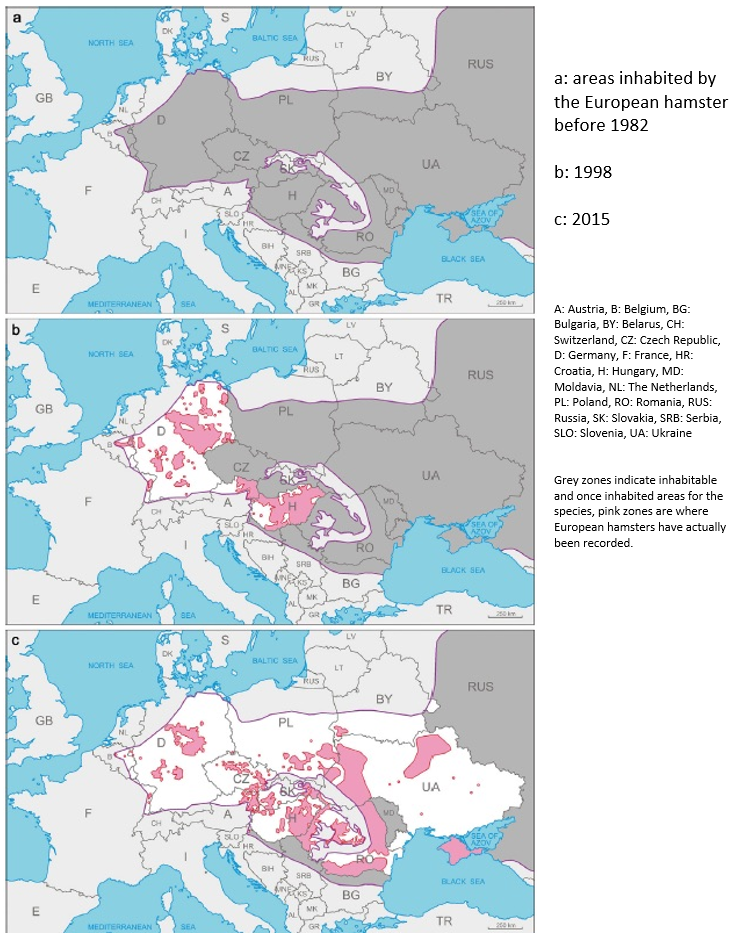The extinction of the European hamster goes beyond just France
21 septembre 2018In France, the endangered European hamster can only be found in the Alsace region, but is also present in Eastern Europe. This species of hamster can be found in Germany, Belgium, Austria, the Netherlands, Poland, Hungary, the Czech Republic, Romania, part of Crimea and Russia. In most of these countries, observers have noted an alarming decline in populations (see map below).
International conference in Strasbourg
Every year since 1994, scientists, experts and informed enthusiasts working to conserve the species come together to discuss the findings of their studies and share their knowledge on the subject. This year, the 25th Hamster WorkGroup conference are set to take place in Strasbourg from 4 to 6 October 2018. The conference will come after the LIFE Alister results symposium, scheduled for 3 October. The conference, organised by LIFE Alister partners, will be held at the Hubert Curien Multi-disciplinary Institute (IPHC) of the French National Scientific Research Centre (CNRS).
Similar findings across the different regions
When pooling their observations, experts from different countries are reaching similar conclusions: the European hamster, which lives in cultivated fields, does not seem to be adapting well to modern agriculture. Weight loss has been recorded in the animal: the mean weight of European hamsters in the Alsace region in France has dropped by 21%* over the last century (from 1937 to 2014), which may have repercussions for the species’ survival and reproductive capacity. It is this decline in reproduction rate that affects the species ability to survive. This decline is very alarming (see the table below taken from the report, ‘Dramatic global decrease in the range and reproduction rate of the European hamster Cricetus cricetus’ by Alexey Surov, Agata Banaszek, Pavel Bogomolov, Natalia Feoktistova, Stefanie Monecke, in 2016): the number of litters per year has dropped from 2.43 in 1914 to 1.63 in 2015, but perhaps more notable is the difference between the number of pups per year per female, falling from 24.69 to 5.58! (download the full report here)
Diet: one possible factor explored by LIFE Alister
The research conducted in France by Mathilde Tissier and Caroline Habold from the CNRS Hubert Curien Multi-disciplinary Institute has paved the way for the factor of vitamin intake, and more specifically a B3 vitamin deficiency in a corn-based diet, to be taken into consideration. Monoculture may largely prevent the animal (and other species too) from having a varied diet, which may lead to serious deficiencies.
Research led by the CNRS, the Alsace Regional Chamber of Agriculture and the French National Hunting and Wildlife Agency (ONCFS) is currently under way, with farmers taking part in agronomic trials that are favourable to the European hamster. This type of partnership is the first of its kind in Europe. In fact, the system used in France for conducting trials appeals to a number of European countries, because of the agri-environment measure (MAE) collectives. This system allows for trials and tests to be carried out on a contract basis on a group of agricultural plots, which provides more conclusive results.
Other countries taking part in the Hamster WorkGroup conference are also developing techniques to conserve the animal and it is through this sharing of experiences that Europeans hope to curb the extinction of this species, which more pessimistic views predict will be 2020 and 2038 (source: ‘Dramatic global decrease in the range and reproduction rate of the European hamster Cricetus cricetus’ by Alexey Surov, Agata Banaszek, Pavel Bogomolov, Natalia Feoktistova, Stefanie Monecke, in 2016).
Agricultural technique developed in the Netherlands
Hamsters in the heart of Vienna
On Facebook: Conservation of the European hamster in Poland and Germany
* http://www.grand-hamster-alsace.eu/declin-du-hamster-en-alsace-pistes-reponses/





